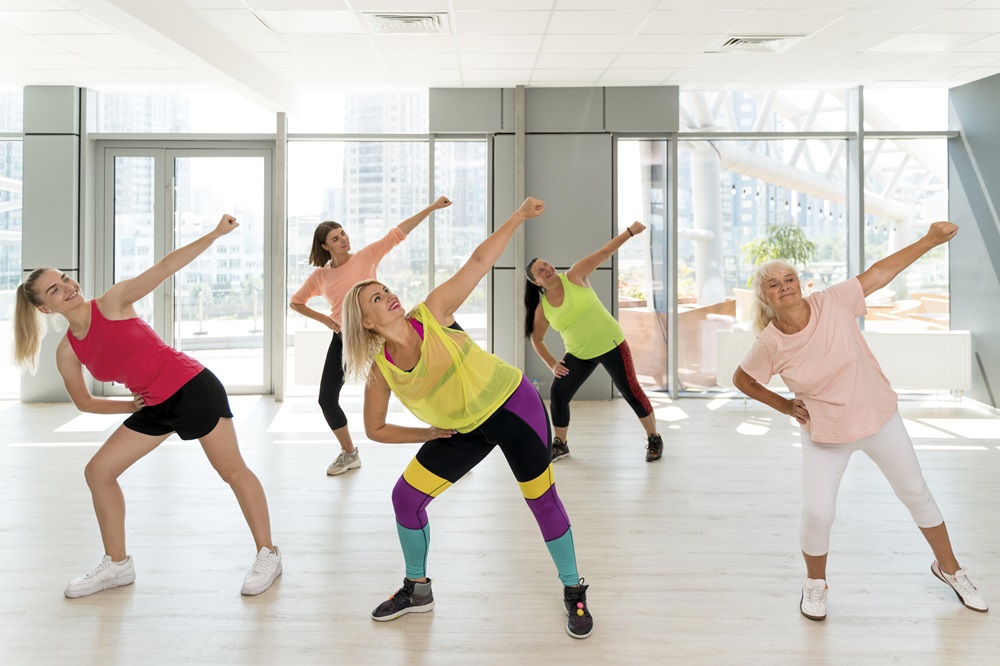Zumba – Types, Benefits, and Effects

Zumba is a workout program that combines dance and aerobics. It’s a form of physical activity that, in a short time, has gained huge popularity among people on different continents, regardless of age or skill level. This dynamic training method improves fitness and well-being while also helping to reduce body fat. What is Zumba? How to do Zumba exercises? What results can you expect from practicing Zumba regularly?
Table of contents
What is Zumba?
Zumba is a unique form of exercise that blends Latin American dance and belly dancing with elements of fitness. It’s a licensed workout program created in the 1990s by Colombian dancer and choreographer Alberto “Beto” Perez, who, on his way to an aerobics class, forgot to bring the usual music tracks for the session. As a result, he had to improvise to the Latin music available in the studio, which gave birth to a workout routine built around Latin rhythms.
In 2001, the creator of Zumba moved to Miami, where he promoted this innovative training method. That’s where he met Alberto Perlman, who later became Zumba’s chief executive officer.
Although Zumba training started by accident, it quickly revolutionized the fitness industry, becoming extremely popular in the United States and later spreading to Europe and other continents.
Types of Zumba workouts
The growing popularity of Zumba led to certain modifications in the program, resulting in more than a dozen different variations of the workout. Today, the main Zumba training methods include:
- zumba basic – beginner-friendly Zumba exercises using simple dance routines, designed to be enjoyable and a fun way to relax.
- zumba toning – an endurance workout that often uses extra weights, such as dumbbells, to boost the effectiveness of the exercises.
- zumba fit – an advanced training method focusing on fitness and stamina, offering an intense and dynamic workout.
- zumba sentao – a workout style that uses chairs as part of the choreography.
- zumba aqua – exercises performed in a swimming pool.
- zumba kids – a dance-based activity designed for children, making movement a form of play.
- zumba gold – simple dance routines aimed at warming up and stretching the whole body, intended for pregnant women and older adults.
Zumba exercises – how it works
Zumba combines aerobic exercises with dance, making it an excellent form of cardio training. It is most often practiced in a fitness studio under the supervision of a qualified instructor.
A Zumba session should start with a proper warm-up, focusing mainly on the thighs, abdomen, and glutes – the parts most engaged during the workout. Then comes the main session, which involves following the instructor’s movements, repeating choreographed sequences with different types of exercises to lively, upbeat music.
Zumba routines are based on simple, easy-to-remember steps, usually performed at varying speeds, sometimes resembling interval training. At the end, the focus shifts to stretching exercises, which help calm and relax the body after the intense effort.
A typical Zumba workout lasts about 45 to 60 minutes. Nowadays, it’s practiced not only to Latin music but also to other rhythms, such as hip-hop, salsa, or flamenco.
Zumba – who is it for?
Zumba is a universal form of physical activity that, thanks to its many variations, can be tailored to individual needs. This means almost anyone can do Zumba, regardless of age or skill level.
It’s a great way for people who don’t enjoy intense workouts to start living a more active lifestyle. It’s also a perfect option for sports enthusiasts who want to add variety to their daily exercise routines.
Is Zumba worth doing? Benefits of Zumba
Zumba is a unique form of exercise that can have a positive effect on the body’s performance. It can improve overall fitness and increase body mobility. Zumba can also enhance coordination and motor skills.
The combination of dance and aerobics may improve breathing and oxygen capacity, benefit the spine and posture, and strengthen deep muscles. On top of that, Zumba can help reduce stress by lowering cortisol levels, oxygenate the body, and support the healthy functioning of the cardiovascular system.
Zumba workouts can improve mood and help the body relax. It’s a fun way to combine pleasure with physical benefits, increasing flexibility, muscle strength, and endurance, all while shaping a toned and fit figure.
Zumba for weight loss – can you slim down with Zumba?
Zumba enjoys worldwide popularity, largely because the combination of dance and aerobics can help reduce body fat, support weight loss, and make it easier to reach your desired body weight.
Zumba training can boost calorie burning, allowing you to burn 500–700 calories during a one-hour session. This makes Zumba for weight loss an increasingly popular choice and an effective way to achieve a slim, well-shaped body.
To speed up weight loss, it’s best to focus on more dynamic Zumba styles, such as Zumba Fit. Another good option is adding weights or incorporating strength-training elements into the workout.
Zumba – when will you see results?
The benefits of Zumba can be felt after the very first session – you might notice better mood, reduced stress, and a relaxed body.
Zumba results after a month – what can you expect from regular training? After 3–4 weeks of consistent practice combining dance and aerobics, you may notice improved fitness, greater muscle endurance, and weight loss.
Zumba for beginners at home – how to start?
Although Zumba is most often practiced in a studio with a group and an instructor, there’s no reason you can’t do it at home.
Experienced people familiar with dance-aerobic training can simply put on sportswear, find some free space in the apartment, turn on music, and start moving. Beginners can easily find online courses and various workout videos to learn the basics of Zumba and have fun in their own space.
Doing Zumba at home doesn’t require special equipment. You just need some free space.

